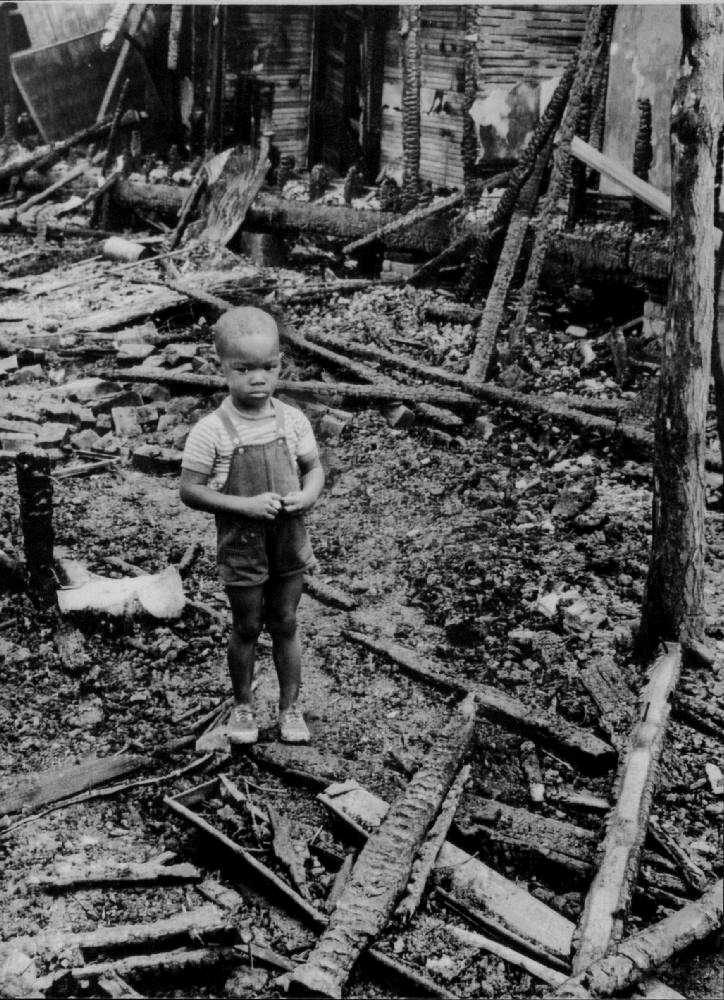
The American Civil Rights Movement: Race Riots (1965-68)

Figure 1.--This press photograph was taken in Detroit in the aftermath of the Juky, 1967 riots. The caption read, "Three-year-old Thomas Allen stands in the ruins of his home on Detroit's east side after it was burned tobthe ground in the riots that hit the city July 23. Little Thomas' bewildered appearance is symbol of the riots' most tragic victims. Thomas along with his mother, is now staying at one of the seven emergency housing centers set up for refugees."
|
|
Through much of American history, race riots meant mobs of whites attacking blacks. There are many examples such as the New York City Draft Riot (1863) and the Detroit race riot (1943). These riots included not only destroying communities, but killing people as well. This changed in the aftermath of major achievements in Civil Rights. This time it was blacks rather than whites rioting and the focus seems primarily on the police and property. The riots are unusual in that race, ethnic, religious riots normally was one group coming into another groups neighborhood to attack them. These race riots were blacks rioting and destroying property in their own neigborhoods. Despite the momentous achievement of two landmark Civil Rights Acts, northern citirs exploded--the long hot summer (1965). It seems incongrous why the riots would occur just at the time that the Civil Rights movement had accomplished its major objectives, ending segregation and achieving voting rights in the south. This would seem a time to celebrate rather than riot. Perhaps the national dialog and new coverage on race was a factor. Much of this was a revelatin for whites, but one would think nothing new to blacks. Surely black people living in the inner city had grevances, but it is difficult to see just what was to be accomplished by rioting. This is of course especially true when it burning down your own neigborhoods. Of course rioting is usually not a coherent act. Most of the riots were in larger Northern cities. The first major urban riot conducted by blacks was in Watts, a suburb of Los Angeles (1965). Major riots occurred in Newark and Detroit (1967). The rioters did emense damage, often destroying the ecionomic base of the communities affected. The assasination of Dr. King (April 4, 1968) brought spasms of violence in many cities, this time including southern cities. Often this was mixed with local grievances. In Washington, D.C., Stockley Carmichael who helped found the Student Non-Violent Coordinating Committee (SNCC) gathered an agitated group at 14th and U Street (center of the black shopping district) and demanded that stores close to honor Dr. King's memory. The situation soon turned ugly. Rocks were throne and windows smashed. Looters surged into the clothing stores, five and dimes, liquor, appliance, and other stores. Then the torching began. Three days of rioting followed. The police were totally unable to control the situation. The riots were finally only supressed with over 10,000 U.S. Army trops arrived. More than 1,000 people were injured and 12 people killed. Arrests totaled 6,100. About 900 stores were ruined. The black shopping district was devestated and would take decades to recover.
HBC

Navigate the Boys' Historical Clothing Web Site:
[Return to Main Civil Rights page]
[Return to Main specific war and crisis page]
[Introduction]
[Activities]
[Biographies]
[Chronology]
[Clothing styles]
[Countries]
[Bibliographies]
[Contributions]
[FAQs]
[Glossaries]
[Images]
[Links]
[Registration]
[Tools]
[Boys' Clothing Home]
Created: 1:27 AM 2/13/2012
Last updated: 1:27 AM 2/13/2012



